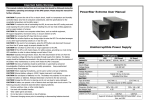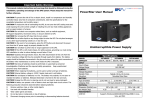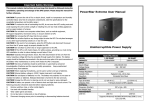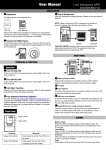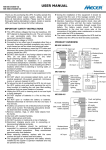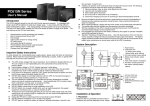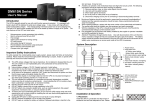Download Bonnie DC UPS Quick Guide
Transcript
Bonnie DC UPS Quick Guide 1 V.1.1 NOTE: Before installation, please inspect the unit. Be sure that nothing inside the package is damaged. Introduction The UPS is exclusively designed for communication devices such as hub, switch and modem. Featuring with dynamic voltage regulator, the UPS can ensure stable DC power to connected loads as utility. The built-in DC start function enables the UPS to be started up without a supply of AC power. The main features of this UPS are listed below: Dual DC outputs Microprocessor controlled guarantees high reliability Compact size for standing and mounting flexibility Supports solar powered devices and communication applications Auto restart while AC is recovering Off-mode charging Overload protection and short circuit protection 2 Front View: 1 1 Power switch 2 AC mode indicator: green lighting 3 Battery mode indicator: yellow lighting indicates battery mode yellow flashing indicates low battery 4 Fault indicator: red lighting 4 Back View: Output options: 1 Model Bonnie-30 Output options 6VDC and 12VDC 12VDC and 24VDC Bonnie-50 Placement & Storage Conditions Install the UPS in a protected area that is free of excessive dust and has adequate air flow. Please place the UPS away from other units at least 20 cm to avoid interference. Do NOT operate the UPS where the temperature and humidity is outside the specific limits. (Please check the specs for the limitations.) 20cm 20cm Connect to Utility and Charging Before initial use, please plug in the AC input cord to the wall outlet and turn on the UPS for charging. For the best results, suggest to charge the battery at least 6 hours before initial use. The UPS charges its battery while connecting to the utility with power on. Product Overview 2 3 3 Installation & Initial Startup 2 x 12VDC 2 1 AC input 2 2 x DC output screw terminals: (see output options table) 6 hours Connect the Loads There are two options for output terminals: 6VDC/12VDC and 12VDC/24VDC. Please verify acceptable voltage of connected device before connecting the wires. Then follow terminal printing to connect the positive and negative terminals to the devices. Turn On/Off the Unit Turn on the UPS unit by pressing and holding the power switch for 4 seconds. Turn off the UPS unit by pressing and holding again the power switch for 4 seconds. Connected devices will be protected by the UPS when turning on the UPS. Indicators & Alarm Table for Operation Conditions Visual Indications AC mode Green LED lighting Yellow LED lighting Battery mode Low battery at Yellow LED flashing battery mode Fault Red LED lighting Alarm Off Sounding every 10 seconds Sounding every second Continuously sounding 4 Important Safety Warning ( SAVE THESE INSTRUCTIONS) CAUTION! To prevent the risk of fire or electric shock, install in a temperature and humidity controlled indoor area free of conductive contaminants. (See the specifications for the acceptable temperature and humidity range.) CAUTION! To reduce the risk of overheating the UPS, do not cover the UPS' cooling vents and avoid exposing the unit to direct sunlight or installing the unit near heat emitting appliances such as space heaters or furnaces. CAUTION! Do not attach non-computer-related items, such as medical equipment, life-support equipment, microwave ovens, or vacuum cleaners to UPS. CAUTION! Do not plug the UPS input into its own output. CAUTION! Do not allow liquids or any foreign object to enter the UPS. Do not place beverages or any other liquid-containing vessels on or near the unit. CAUTION! In the event of an emergency, press the OFF button and disconnect the power cord from the AC power supply to properly disable the UPS. CAUTION! Do not attach a power strip or surge suppressor to the UPS. CAUTION! If the UPS is with metal chassis, for safety purpose, grounding is a must during UPS installation in order to reduce leakage current below 3.5mA. Attention hazardous through electric shock. Also with disconnection of this unit from the mains, hazardous voltage still may be accessible through supply from battery. The battery supply should be therefore disconnected in the plus and minus pole at the quick connectors of the battery when maintenance or service work inside the UPS is necessary. CAUTION! Servicing of batteries should be performed or supervised by personnel knowledgeable of batteries and the required precautions. Keep unauthorized personnel away from batteries. CAUTION! When replacing the batteries, use the same number and type of batteries. CAUTION! Internal battery voltage is 12Vdc. Sealed, lead-acid, 6-cell battery. CAUTION! Do not dispose of batteries in a fire. The battery may explode. Do not open or mutilate the battery or batteries. Released electrolyte is harmful to the skin and eyes. CAUTION! Unplug the UPS prior to cleaning and do not use liquid or spray detergent. CAUTION! A battery can present a risk of electric shock and high short circuit current. The following precaution should be observed before replacing batteries: 1) Remove watches, rings, or other metal objects. 2) Use tools with insulated handles. 3) Wear rubber gloves and boots. 4) Do not lay tools or metal parts on top of batteries. 5) Disconnect charging source prior to connecting or disconnecting batteries terminal. 5 Trouble Shooting Use the table below to solve minor problems. Problem No LED display on the front panel. Probable Cause Low battery. Battery fault. The UPS is not turned on. Alarm continuously sounds when the mains is normal. The UPS is overload. UPS fault The mains is normal Power cord is loose. but yellow LED is lighting. 6 Solution Charge the UPS at least 6 hours. Replace the battery with the same type of battery. Press the power switch again to turn on the UPS. Remove some loads first. Before reconnecting equipment, please verify that the load matches the UPS capability specified in the specs. Return the unit to service center. Reconnect the power cord properly. Specifications Model CAPACITY INPUT Voltage Voltage Range Frequency OUTPUT Output Voltage Bonnie-30 Bonnie-50 30 W 50 W 230 VAC 160~280 VAC 50 Hz 110 VAC or 220 VAC 80-140 VAC or 160-280 VAC 60 Hz or 50 Hz Dual outputs: 6VDC/12VDC 2 x 12VDC or 12VDC/24VDC Output Voltage Regulation 12V: +15% and -12% 6V: ±10% +15% and -12% 24V: ±5% Transfer Time 0ms EFFICIENCY AC Mode 70% 75% Battery Mode >90% 95% BATTERY Type 12 V / 9 Ah x 1 Charging Voltage 13.7 V ±0.25 V Charging At no load 2.8A @ 110 VAC 3A Current 2.3A @ 220 VAC At full load < 1A 0.7 A 4-6 hours recover to 90% capacity Typical Recharge Time PHYSICAL 228 x 82.5 x 207 Dimension (DxWxH mm) 3 Net Weight (kgs) ENVIRONMENT Humidity 0-90 % Temperature 0-40 C (non-condensing)


